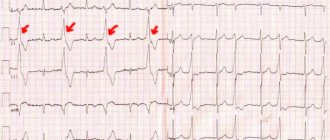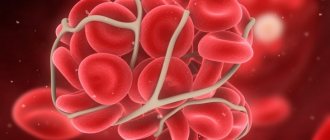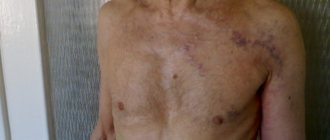What it is
A special artery is responsible for the blood supply to the spleen. If the lumen of the vessel narrows due to spasm or becomes clogged with a blood clot, then the nutrition of the organ is sharply disrupted. Ischemia occurs, and then tissue necrosis. If, as a result of circulatory problems, necrotic changes appear in the organ, then doctors diagnose a splenic infarction.
The disease is more common in older people. This is due to age-related changes in blood vessels. Pathology is observed with equal frequency in men and women.
Etiology
What can lead to necrosis of the tissues of the hematopoietic organ? Doctors identify the following causes of splenic infarction:
- Oncological diseases of the hematopoietic organs (leukemia, lymphoma). These pathologies lead to blockage of the splenic artery by blood clots.
- Changes in blood composition. A decrease in hemoglobin and an increase in platelet counts contribute to the appearance of clots in blood vessels.
- Heart diseases. In cardiac pathologies, blood circulation slows down, which leads to impaired nutrition of the spleen tissue.
- Vascular pathologies (vasculitis, atherosclerosis, endarteritis). These diseases are accompanied by narrowing of the lumen of blood vessels and circulatory disorders.
- Abdominal injuries. Bruises of the spleen often provoke the formation of blood clots in the arteries of the organ. When rib fractures occur, the vessels may be damaged by bone fragments.
- Infectious pathologies. Against the background of general intoxication of the body, spasm of the splenic artery occurs, which leads to a deterioration in the blood supply to the organ.
- Neoplasms in the spleen. Tumors in this organ compress the blood vessels. This causes ischemia and then heart attack.
- Long-term use of hormonal contraceptives. A side effect of estrogens is blood clots.
Causes of splenic infarction
The main immediate cause of splenic infarction is a sharp deterioration in blood flow to it through the system of blood vessels, which is observed due to a decrease in their lumen. The splenic artery specifically suffers - pathological changes affect its main trunk or individual branches. The larger the branch, the more the blood flow suffers, the larger the area of the spleen parenchyma becomes “hostage” to the impaired blood supply and undergoes necrosis.
In turn, a decrease in the cross-section of blood vessels can be observed due to the following reasons:
- anatomical;
- functional.
In the first case, the lumen of blood vessels decreases due to:
- their blockages from the inside (obstructive type of blood flow disturbance);
- compression from the outside (restrictive type of blood flow disorder).
In the second case, a decrease in the lumen of the splenic artery or its branches may occur due to their:
- spasm;
- paralysis
Spasms of the vascular walls are reversible - when the spasms “pass”, the blood flow through them (and therefore the nutrition of the splenic parenchyma) can be fully resumed.
In some cases, a combination of anatomical and functional causes of impaired blood flow through the vessels of the spleen is observed.
The splenic artery and its branches can be blocked by:
- thrombus;
- embol.
A thrombus is a blood clot that forms on the inner surface of the vascular wall and interferes with the flow of blood through the vessel.
An embolus is any object that is capable of moving through the lumen of blood vessels. The most common forms of embolus are:
- detached blood clot;
- adipose tissue;
- conglomerate of parasites;
- air bubbles.
Important
First of all, it is necessary to be wary of embolization of the splenic artery and its vessels, since, unlike the formation of a blood clot, it often occurs acutely - the embolus can suddenly be carried by the bloodstream and provoke the development of a splenic infarction.
A thrombus turns into an embolus if it is old, large, and the blood literally “rocked” it and tore it away from the vessel wall.
Thrombosis is observed in a number of diseases and pathological conditions. They are divided into groups:
- malignant blood diseases;
- malignant lesion of lymphoid structures;
- changes in blood properties;
- heart pathology;
- systemic and inflammatory diseases;
- traumatic injury;
- infectious diseases – bacterial and parasitic;
- diseases of the spleen itself.
Of all malignant hematological diseases, the following pathologies most often provoke the formation of blood clots, embolization of great vessels and the development of splenic infarction:
- lymphoma is a disorder of lymphoid tissue in which an uncontrolled accumulation of “tumor” lymphocytes is observed in the blood;
- leukemia is a malignant clonal pathology of the hematopoietic system. In this case, the clone originates from immature blood cells of the bone marrow, as well as maturing and mature blood cells.
Of all the lymphoid pathologies, lymphogranulomatosis, a malignant pathology of lymphoid tissue in which specific giant cells appear in the blood, most often leads to thrombus formation and blockage of the splenic artery.
Changes in blood properties that can provoke thrombus formation may occur against the background of:
metabolic disorders of total protein and its fractions;- prolonged use of oral contraceptives;
- erythropoietin therapy (this is one of the kidney hormones that controls the production of red blood cells);
- sickle cell anemia - a disorder of red blood cells in which they acquire a specific shape;
- hemolytic anemia - a decrease in the number of red blood cells due to their destruction;
- congenital and acquired disorders of the blood coagulation system.
Thrombosis in such cases is observed because the composition and rheological properties (fluidity) of the blood change.
Heart disease can lead to the formation of blood clots due to the fact that against their background, blood flow slows down, which is why blood clots form, which then enter the splenic artery system. First of all, these are diseases such as:
- infective endocarditis - bacterial damage to the inner layer of the heart;
- defects of the valve apparatus - a violation of their structure and, as a consequence, closure;
- myocardial infarction – necrosis of a section of the heart muscle due to impaired cardiac blood flow;
- heart rhythm failure
and some others.
Systemic and inflammatory vascular diseases are involved in thrombus formation for the reason that they lead to a narrowing of the lumen of the vessel, and then its blockage, and can also provoke the formation of blood clots on the damaged fragment of the vessel, their separation and further blockage of the splenic artery.
First of all, these are pathologies such as:
- vasculitis - inflammatory damage to the vascular wall with its subsequent destruction;
- atherosclerosis - the formation of an atherosclerotic plaque on the inner surface of a vessel with a subsequent decrease in its lumen and deterioration of blood flow through it;
- obliterating endarteritis is a progressive lesion of the arteries, which is accompanied by their stenosis (narrowing) and obliteration (overgrowth).
Traumatic lesions can be involved in splenic infarction in the sense that they also form blood clots, which, having come off, are carried with the bloodstream into the splenic artery system. In addition, trauma can lead to fat and air embolism, which also causes splenic infarction. Of all the traumatic injuries, the most important in the context of the described pathology are:
- open or closed damage to the abdominal organs;
- the same damage to the chest organs;
- rib fractures.
Infectious diseases can provoke the development of infectious-toxic shock, which causes centralization of blood circulation, spastic changes in the vessels of the spleen and the formation of a heart attack. Often this is:
- sepsis – the spread of an infectious agent through the bloodstream throughout the body with the possible formation of secondary infectious foci;
- typhus - damage to the body by rickettsia with subsequent disorders of the nervous and cardiovascular systems;
- malaria - infection by plasmodia (transmitted through the bites of female malarial mosquitoes), which entails periodic fever
and a number of others.
Some diseases of the spleen can also lead to a spleen infarction. Mainly:
- torsion of the mobile spleen;
- her cyst.
In this case, compression of the splenic vessels occurs, disruption of blood flow with subsequent disruption of nutrition and, as a result, ischemia, which develops into a splenic infarction.
Compression of the splenic artery from the outside less often leads to the described pathology. Pressure on the splenic artery can be:
- tumors;
- scarring;
- foreign bodies;
- connective tissue cords.
note
The lumen of the splenic artery, against the background of narrowing of which a splenic infarction develops, can be changed due to its congenital anomalies - in particular, torsion.
Spasm and paralysis of the splenic artery, in comparison with the described pathologies, become causes of disruption of blood flow through it quite rarely.
A separate category of causes of splenic infarction is rupture of the splenic artery, which cannot be classified as either a restrictive or an obstructive type of blood flow disorder.
Types of pathology
Symptoms, treatment and prognosis of splenic infarction largely depend on the form of the pathology. Doctors distinguish the following types of this disease:
- ischemic;
- hemorrhagic.
Let us consider these forms of the disease in more detail. Ischemic splenic infarction occurs due to acute blockage of the splenic artery or its branches. As a result, the organ is very poorly supplied with blood. Changes in tissue color are a characteristic sign of the ischemic form of splenic infarction. A description of the color of the organ can be found in specialized medical literature. Its tissues become very pale due to lack of blood supply. Therefore, this form of pathology is otherwise called white infarction.
With a hemorrhagic type of heart attack, the organ is filled with blood. The splenic artery is blocked. However, blood enters the organ through bypass routes, and its outflow is disrupted. Hemorrhagic infarction also occurs due to venous stagnation. Foci of necrosis appear in the spleen, which look like hematomas.
Treatment of pathology
Most splenic infarctions, especially asymptomatic forms, do not require surgical intervention. Surgery is only necessary for abscess, sepsis, pseudocyst formation, or bleeding.
Drug therapy
Due to the rarity of this disease, special clinical recommendations for its drug therapy have not been developed. The basis of treatment is painkillers. Narcotic analgesics may be used first, followed by nonsteroidal anti-inflammatory drugs.
Additionally, antibiotics or antiplatelet agents may be prescribed. The underlying disease that caused the splenic infarction is treated.
Surgical intervention
Whenever possible, surgeons strive to preserve the spleen. But as complications of a heart attack develop, their help becomes necessary.
- If the vascular pedicle is torsioned, splenopexy is performed - suturing the organ to the surrounding tissues, omentum, or placing it in the retroperitoneal space. Laparoscopy may be used.
- Bleeding or a pseudocyst can be eliminated by partial splenectomy - removal of part of the organ.
- A unilocular abscess can be treated by puncturing the skin and draining, that is, washing.
Removal of the spleen
To reduce blood loss, the splenic artery is embolized before surgery or ligated during the procedure itself.
Before surgery, the patient is prescribed antibiotics, intravenous solutions, and Heparin.
If a splenic infarction has developed in a patient with an oncohematological disease (leukemia), preoperative chemotherapy may be useful.
If necessary, the spleen is removed either openly or laparoscopically. An operation with opening the abdominal cavity is often performed in emergency cases, when the patient’s condition is serious. Whenever possible, doctors should try to preserve part of the organ.
Open method of removing the spleen
After removal of the spleen, a vaccine against pneumococcus and Haemophilus influenzae is administered. When the platelet count increases to more than a million in 1 microliter, antiplatelet drugs are prescribed. Early rising, administration of Heparin and painkillers are indicated.
Surgical treatment of splenic infarction may be accompanied by the following complications:
- pneumonia;
- postoperative wound infection;
- internal bleeding;
- injury to the pancreas or stomach;
- postsplenectomy sepsis is a rare (0.5%) but fatal complication caused by severe impairment of immune function; Because of this, they try to avoid complete removal of the organ.
The prognosis is determined by the severity of the underlying disease.
Initial manifestations
If the focus of necrosis is small, the patient may not feel any unpleasant symptoms. Quite often, at an early stage, patients do not notice manifestations of ischemia. The spleen contains very few nerve endings. Therefore, at the beginning of the pathology there is no pain syndrome.
The initial symptoms and first signs of splenic infarction manifest themselves only in a slight general malaise and weakness. A person experiences causeless fatigue, which does not go away even after a long sleep and intensifies in the morning. The patient's performance decreases and he gets tired very quickly. However, patients usually do not associate such manifestations with spleen pathology. Seeing a doctor is often postponed.
An early symptom and the first sign of splenic infarction in women can be mild pain. Unpleasant sensations appear on the left under the ribs. In men, there is no pain at the initial stage. This is due to the fact that women have less developed abdominal muscles and the spleen is more mobile.
In addition, women are more likely to suffer from splenic cysts. The cause of this disease can be hormonal imbalances. The cyst is usually accompanied by pain. Organ ischemia occurs due to compression of blood vessels by the tumor. Therefore, the symptoms of splenic infarction are more pronounced in women than in men.
Detailed symptoms
As already mentioned, patients rarely begin treatment at the initial stage of the disease. If the disruption of blood supply continues, the ischemic focus increases over time. New areas of necrosis appear in the tissues. This stage is characterized by the following symptoms of splenic infarction:
- Pain syndrome. Pain occurs on the left side under the ribs and radiates to the back. At first, unpleasant sensations appear periodically, most often after physical activity. As ischemia develops, the pain syndrome becomes constant.
- Dyspeptic phenomena. Patients experience digestive disorders: nausea, diarrhea, lack of appetite.
- Deterioration in general health. Patients' temperature rises to +39 degrees, shortness of breath and rapid heartbeat are noted.
- Feeling of heaviness and fullness under the ribs on the left. This symptom is more often observed in the hemorrhagic form, when blood stagnation forms in the spleen.
Palpation reveals an enlarged spleen. Palpation of the organ is accompanied by severe pain.
With extensive splenic infarction, the symptoms of the pathology are even more pronounced. The pain becomes unbearable. They radiate to the back, stomach area and chest. Patients often mistake such manifestations for signs of heart or gastrointestinal diseases. In the future, intestinal obstruction, severe constipation and bursting pain in the abdomen develop.
Complications
Advanced splenic infarction is dangerous due to its complications. Without treatment, this disease can lead to the following consequences:
- Abscess of the spleen. Dead tissue is very susceptible to infection. If bacteria penetrate them, an abscess forms in the organ. If an abscess ruptures into the abdominal cavity, it can lead to blood poisoning and peritonitis. These conditions threaten the patient's life.
- Bleeding from an organ. This complication is possible with a hemorrhagic form of infarction. Overfilled vessels burst and blood pours into the abdominal cavity.
- Splenic cyst. In necrotic areas, benign tumors filled with fluid can form.
In addition, the affected areas become very vulnerable to all adverse effects. With organ ischemia, even minor physical exertion or a bruise can cause tissue rupture.
Prognosis and prevention
The prognosis of the disease depends on the extent of the lesion, proper diagnosis and treatment. With small sizes of splenic infarction, timely recognition of the disease and implementation of therapeutic measures, the prognosis is favorable. Scar tissue forms at the site of necrosis. A massive infarction, complicated by the formation of a cyst and abscess, can lead to the spread of infection and the development of sepsis. Prevention of heart attack is aimed at rational treatment of chronic diseases that can provoke the development of ischemia and necrosis, and undergoing periodic examinations by the necessary specialists. At the first symptoms of the disease, you should consult a surgeon.
In contact with
LiveJournal
Diagnostics
Diagnosing this disease can sometimes be quite difficult. Indeed, at the initial stage, severe symptoms may be absent. The surgeon begins the examination with an external examination of the patient and palpating the right hypochondrium. On palpation, an enlargement of the organ is determined; in the later stages, pain is noted when pressed.
In order to determine the nature of the pathology, the following diagnostic procedures are prescribed:
- Ultrasound. Splenic infarction can be easily detected using ultrasound. The examination shows an increase in the organ and changes in the structure of tissues in areas of ischemia.
- MRI. This is the most accurate diagnostic method. Using tomography, you can determine the location and size of areas of necrosis.
- Duplex scanning. This study shows changes in the splenic artery and its branches.
- Biopsy of the spleen. This diagnostic procedure is rarely prescribed, as it is quite traumatic. However, puncture is necessary if complications are suspected. Under local anesthesia, the doctor makes a puncture in the area of the spleen and takes a piece of tissue for microscopy.
In some cases, a clinical blood test is prescribed. But in the initial stages this test is not very informative. Blood counts may remain within normal limits. Only in the later stages are signs of anemia noted, as well as an increase in leukocytes and ESR.
Therapeutic measures
The fight against splenic infarction consists, first of all, of treating the underlying disease that caused vascular thrombosis. For example, anticoagulants to prevent subsequent thrombosis, treatment of blood diseases (leukemia, lymphoma) with chemotherapy.
Surgical treatment is indicated only if complications occur - ruptures or abscesses. In other situations, doctors adhere to conservative observational tactics. Ultrasound examinations or computed tomography with contrasting of blood vessels are performed to determine the size of the infarction zone.
Splenic infarction is a fairly rare but serious disease.
It is important to constantly be under the supervision of doctors in order to begin treatment of complications that have begun in a timely manner.
Conservative therapy
If the foci of necrosis are small, then conservative treatment of splenic infarction is possible. The patient is advised to avoid any physical activity and maintain bed rest.
To reduce pain, cold compresses are applied to the spleen area. Analgesics and antispasmodics are also prescribed:
- "Ibuprofen."
- "Ketanov."
- "Analgin."
- "Baralgin."
- "Spazmalgon."
In the ischemic form of the pathology, the drug "Warfarin" is prescribed. It is an anticoagulant that prevents blood clots. However, in case of hemorrhagic infarction, this drug is strictly contraindicated, as it can provoke bleeding.
In the early stages, injections of the drug “Fibrinolysin” are prescribed. It breaks down fibrin threads, from which blood clots subsequently form.
Antibiotics are prescribed for prophylactic purposes:
- "Ciprofloxacin."
- Azithromycin.
- "Erythromycin".
- "Ceftriaxone".
Antibacterial therapy helps prevent infection of the affected tissues and the formation of an abscess.
How to treat
In case of splenic infarction, treatment should be carried out in a hospital setting. Therapeutic tactics are drawn up individually depending on the patient’s condition and the extent of damage to the organ parenchyma. Therapeutic measures are preceded by establishing the cause of necrosis. Both medication and invasive intervention are expected.
In case of a mild form of heart attack, the patient is advised to rest in bed, apply cold to the location of the spleen, and take analgesics. Mental and physical stress are contraindicated.
Medicines
Patients with splenic infarction are prescribed medications that reduce blood clotting. Their action is aimed at preventing thrombus formation. For minor lesions, you can limit yourself to taking painkillers.
Important information: Stages of rehabilitation of patients after myocardial infarction at home
Drug therapy is also necessary in the postoperative period. When the cause of the disease is a change in the basic properties of the blood, which often happens when treating cellular anemia with erythropoietin, anticoagulants are prescribed. Drugs in this group inhibit the rate of blood clotting. Warfarin or Heparin are often used.
After surgery, broad-spectrum antibiotics are always prescribed, such as Azithromycin, Ofloxacin, Cefazolin, Ceftriaxone, Erythromycin. In addition, the use of fibrinolytics is indicated; they help destroy already formed blood clots. This is Streptokinase or Fibrinolysin. Anti-inflammatory drugs and immunostimulants are also prescribed.
Surgical methods
In case of extensive heart attack, as well as a high risk of complications, surgery is necessary. During surgery, dead tissue or the entire organ is removed. Currently, operations on the spleen are performed mainly by laparoscopic methods.
Even complete removal of the spleen does not adversely affect the patient's health. In this case, the function of hematopoiesis is taken over by the bone marrow or liver. Recovery after surgery takes several weeks. During the rehabilitation period, you must follow a gentle diet and wear a special bandage. After surgery, the patient is prescribed a course of drug therapy. Analgesics, antibiotics, immunomodulators and anticoagulants are prescribed.
Treatment of splenic infarction
If a splenic infarction is suspected, hospitalization in a clinic is necessary . Treatment tactics depend on the degree of organ damage and the general condition of the patient. First of all, the cause that caused the disruption of the blood supply to the spleen should be eliminated, then the pathology itself should be treated.
For minor necrosis, the scope of treatment is as follows:
- strict bed rest;
- cold on the left hypochondrium;
- anticoagulants.
In case of an extensive form of splenic infarction, surgical treatment is performed - removal with a classic open or laparoscopic approach. Some clinicians suggest removing a fragment of the spleen that has undergone necrotization - but the structure of the splenic parenchyma is such that its suturing is technically extremely difficult, therefore, in case of extensive infarctions of the spleen, it is necessary to completely remove it (splenectomy).
Conservative treatment for extensive necrosis is also used, but as an additional treatment. This:
- antibacterial drugs;
- anticoagulant agents;
- infusion therapy – for the purpose of detoxification. In this case, electrolytes, salt preparations, blood serum, glucose, and so on are administered intravenously;
- immunostimulating drugs - for replacement purposes.
During the rehabilitation period the following are prescribed:
- gentle diet;
- physiotherapeutic procedures to prevent the formation of adhesions in the abdominal cavity;
- wearing a bandage to avoid the formation of postoperative hernias.
Nutritional Features
As already mentioned, the spleen is responsible for hematopoiesis. With pathologies of this organ, the patient’s hemoglobin and red blood cell counts decrease. Therefore, you need to regularly include foods rich in iron in your diet. This element is necessary for the normal formation of blood cells.
Iron is found in the following foods:
- beef and pork liver;
- lungs;
- buckwheat;
- seaweed;
- pomegranates;
- citrus fruits;
- walnuts.
It is necessary to limit the amount of salt in the diet and completely eliminate alcohol. Alcohol negatively affects the functioning of the hematopoietic organ.
Folk remedies
It is impossible to cure spleen pathology with home remedies alone. However, traditional medicine recipes can be used during the recovery phase, for example, after surgery. It is recommended to use decoctions of the following plants:
- chamomile;
- calendula;
- sage;
- St. John's wort.
These herbs have an anti-inflammatory effect. Their use promotes rapid restoration of damaged tissues.
Forecast
With timely drug therapy or surgery, a complete cure is possible. However, the outcome of the disease is influenced by the overall health of the person. If a heart attack is provoked by dangerous pathologies (for example, heart disease or leukemia), the prognosis worsens. The hemorrhagic form of heart attack is more difficult to treat than the ischemic form.
The mortality rate for this pathology is less than 1.5%. A lethal outcome is observed in the presence of complications such as multiple abscesses, sepsis, peritonitis, as well as severe bleeding.
Prevention
How to prevent the occurrence of a heart attack of the hematopoietic organ? Surgeons advise following the following recommendations:
- Protect the abdominal area from bruises and other injuries.
- Limit consumption of foods with cholesterol. Such food contributes to the development of atherosclerosis, and this is one of the causes of circulatory disorders.
- Timely cure infectious diseases, as well as pathologies of the heart and blood vessels.
- Avoid heavy lifting.
- While taking hormonal contraceptives, regularly take blood tests for coagulation and platelet counts.
These measures will help significantly reduce the risk of splenic ischemia.
Is chocolate ok for diabetics?
Have you been struggling with HYPERTENSION for many years without success?
Head of the Institute: “You will be amazed at how easy it is to cure hypertension by taking it every day...
If you have diabetes and love sweets, there is no reason to worry: despite dietary restrictions, chocolate for diabetics is not on the list of forbidden foods. There are several types of chocolate. But patients with diabetes need to know what properties they have and which type will not harm them. They can get useful information by talking with a nutritionist or their doctor.
The high sugar content in foods is the main reason why they should not be consumed if you have diabetes. But with the right approach to this problem, you can improve your quality of life.
Can you eat sweets if you have diabetes?
With diabetes mellitus, a person experiences disruptions in metabolic processes. This leads to serious dietary restrictions, for example, you need to exclude fat and sugar.
Such people should not use:
- baked goods;
- candies;
- cakes;
- carbonated sweet drinks;
- sweet fruits and berries.
Living under this regime is quite difficult. Any violation of the diet threatens a sharp increase in plasma glucose. Even those who don't particularly like sugar and everything sweet sometimes want to treat themselves to something sweet. How to be in this case? Is it possible to eat, for example, chocolate?
And which one to choose, because it happens:
- lactic;
- dessert;
- bitter;
- white.
How to improve your diet? Modern medicine approaches diabetes in a new way. For diabetes mellitus, the diet should include foods that provide the patient with all the necessary nutrients. And if fats, proteins and carbohydrates are in reasonable proportions, there will be no spikes in sugar levels, which means the patient will be protected from hypoglycemia and hyperglycemia.
Which chocolate is the healthiest?
Among all types of this sweet product, dark chocolate will bring particular benefits, especially for diabetes. Why bitter?
Regular chocolate is just a “sugar bomb”. It is very high in calories due to the huge amount of sugar it contains. It should be noted that dark chocolate cannot boast of the fact that it does not have this sweet component at all, but its amount is several times less than in other types.
On the scale of “harmfulness” for diabetics, the first and, perhaps, the only place is occupied by two types of chocolate:
- white;
- lactic.
Dark chocolate can bring not only satisfaction from eating a piece of sweetness, but also certain benefits, because even diabetics need glucose in moderation.
Having studied what dark chocolate consists of, you can be convinced of its undoubted benefits for the body in case of diabetes.
So, diabetic chocolate has the following benefits:
- contains little sugar;
- it contains cocoa beans (about 85%);
- it contains a lot of polyphenols;
- it does not affect the composition of the blood;
- has a low glycemic index;
- it contains vitamin P (which helps reduce the permeability and fragility of blood vessels).
As for the health benefits, diabetic chocolate:
- Reduces the amount of bad cholesterol.
- Reduces blood pressure.
- Supplies the body with iron.
- Gives strength, improves performance.
Since cocoa beans contain polyphenols, which reduce the load on the heart and blood vessels, dark chocolate is even beneficial for diabetics of any type. You can eat it every day, but not exceed the daily norm. It is 30 g.
Every supermarket has a section for diabetics. In it you can choose sweets that will not harm a sick person.
1 vote
2 votes
Get a free consultation
0 votes
Why do you feed pharmacies if hypertension is afraid of the usual like fire...
Tabakov has revealed a unique remedy against hypertension! To reduce blood pressure while preserving blood vessels, add to…
- about the project
- Agreement
- Contacts











